Bit pressed for time tonight, so let’s just enjoy Classic Mac Gaming’s video history of the popular shareware title Glider (10 minutes).
It’s a very simple game, but it had a surprisingly long life. There’s something very Mac-like about it.
The Flipside of Gaming
Bit pressed for time tonight, so let’s just enjoy Classic Mac Gaming’s video history of the popular shareware title Glider (10 minutes).
It’s a very simple game, but it had a surprisingly long life. There’s something very Mac-like about it.
While the original Mac isn’t often considered a top gaming platform, there were neverthless some very nice games for it. One of those was John Calhoun’s classic shareware title Glider. (Glider can be played on Infinite Mac’s emulation of System 6—look in the Games folder in the Infinite Mac disk on the Desktop. The source code is on GitHub.)
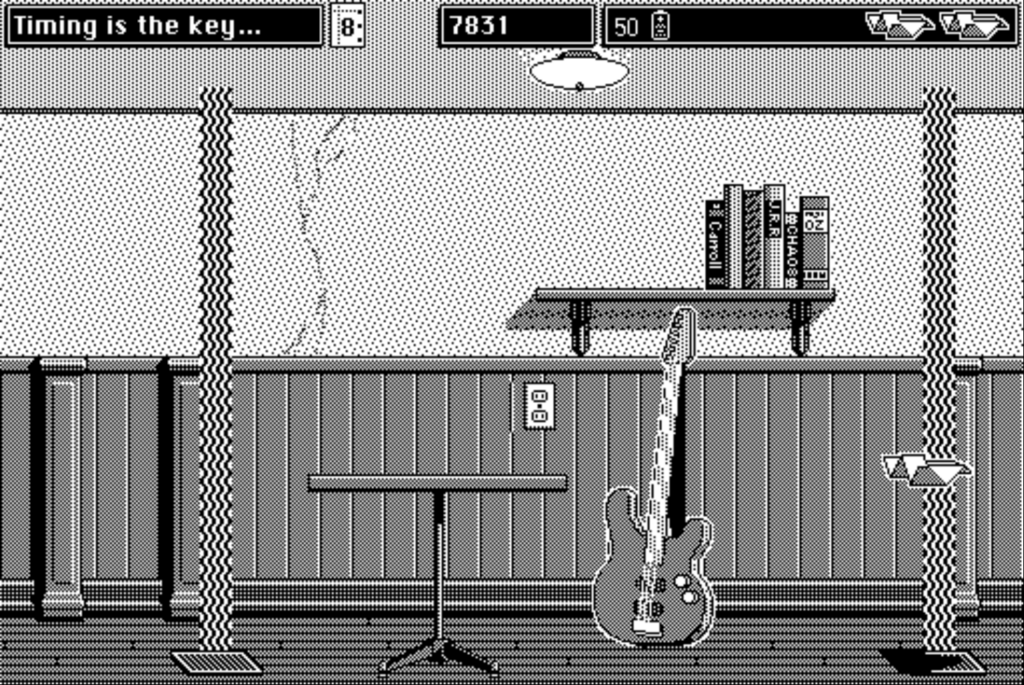
Calhoun had a lot of fun just making prototypes for new Mac games, and so while he didn’t release many there are a number of half-made ones that he’s now put up in their own GitHub repository. Elite-inspired space exploration games, a computer version of the classic Black Box puzzle, a computer aquarium and other ideas are among the presented experiments.
The title of the repo is Unfinished Tales Vol. 1, and there’s already a Volume 2. There really has never been a game playing or development platform like the classic Macintoshes, it’s a window into a lost era of both computing and entertainment. Cameron Talley on Youtube made a 13 minute examination of some of their contents. This is it:
EDIT: I got the name of the chip wrong, as xot pointed out in a comment. I knew the right now but I always get it mixed up. Corrections have been made, here is xot’s comment:
“The 65C02 is a low-power CMOS variant of the venerable 8-bit 6502 with minimal extra abilities. The 6502 successor used in the Apple IIGS is the 16-bit 65C816. It was designed by Western Design Center in collaboration with Apple, Inc. The story that Steve Jobs held back the IIGS in favor of the Mac is popular because it perpetuates Jobs’ mythic status of being a petty, conniving villain … but it isn’t true. The Apple IIGS was created atop a heap of questionable design decisions. No one decision doomed it but its CPU absolutely held it back. The very boring truth is that WDC could not reliably supply ‘816 processors at the speeds they promised (up to 14 MHz). The IIGS is limited to 2.8 MHz because Apple needed a stable product, which unfortunately was way slower than it should have been.”
Some of this slightly contradicts what was said in the video, but not that far. Whether Steve Jobs was petty and conniving or not I will leave to the ages, at least for now.
It had Apple’s first color point-and-click interface, and it ran on a 65C816.
It was the Apple IIGS. It was released two years after the original Macintosh, three after the Lisa, and it worked surprisingly well. It came with 256KB of memory stock but could be gotten with a whole megabyte, and could be expanded to up with 8 MB–in 1986! It supported hard drives and devices could be attached to it via the Apple Desktop Bus. It ran at less than 3MhZ, but its processor was capable of going much faster, with the rumor being that it was a decision of Steve Jobs to limit its processor so it wouldn’t steal the Macintosh’s thunder. (Jobs had been forced out of the company by the time the GS was released, but these decisions are not so easily reversed?)
What’s more the Apple IIGS was made to compete with the Amiga, and so it had considerable audio-visual advantages over the black-and-white Macintosh. 4096 colors and a sound chip designed by the people who had created the SID. And while it had a mode that made it compatible with Apple II software, it used an OS that looked and worked a whole lot like a Macintosh. It was surprisingly capable as a gaming machine; it took a long time, but in 1997 an Apple IIGS version of Wolfenstein 3D was made, although running at a pretty low frame rate:
The 65C816, a 16-bit version of the classic 6502, was used in a number of platforms but ultimately didn’t have the reach of its predecessor. But if Apple had thrown more weight behind the GS, we could well be living in a world where 6502 variants still saw use outside of embedded and hobbyist systems, instead of the Intel and ARM chips that dominate the market today.
I’m thinking along these lines because Vintage Geek made a video about the GS’s virtues, and it’s interesting to speculate about. It really was a kind of wonder machine, and the last gasp of the Apple II line. Here it is (15 minutes):
The IIGS: Apple of Macintosh? (youtube, Vintage Geek, 15 minutes)
I feel like I should adopt some standard way to inform people which items are links to other sites (with minor commentary attached) and which are significant longform items of our own creation.
Suffice to say this is the former category. I didn’t write this history of Kid Pix: Craig Hickman wrote it, back around 2013. And he also created the original version of that program too. And it was terrific. Here is the link.

What was Kid Pix? It was a paint program for early Macintosh models that was very well-received, and is very fondly remembered. It had a powerful UI but was still, neverthless, aimed at kids. Think of it as a more fun version of MacPaint. I refuse to stay in my lane regarding entertaining uses of computers, but perhaps of more interest to what I’d think are our usual readers, it had a similar concept to the art module of Mario Paint, but came out at least a couple of years earlier.
I especially like how he described the original Macintosh UI as having “a consistent and enlightened vision behind it,” which I’m not sure can be said of Macs today, or really of the products of any major software company. That’s just my opinion, mind you.
Did you know there is a Javascript re-implementation of an older version of Kid Pix? Here!
Kid Pix – The Early Years (red-green-blue.com)
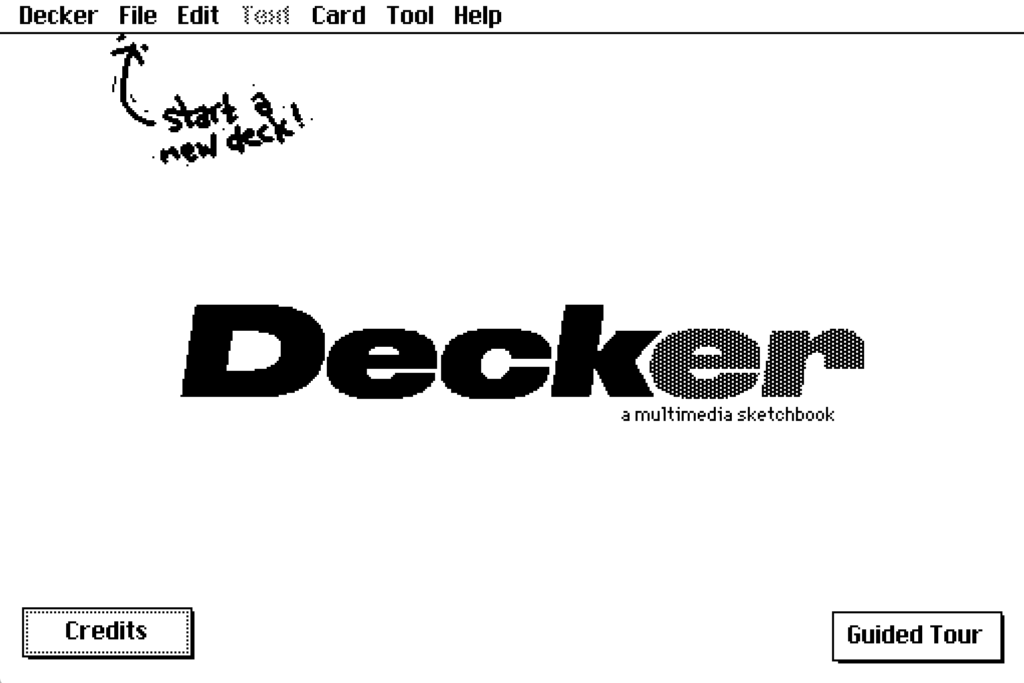
The history of computers is filled with great transformative ideas that never took off, or sometimes, were even actively sabotaged.
One of those ideas was Hypercard, a “multimedia authoring system” for Mac OS Classic. One way to describe it is like an individual website, contained within a file on your computer, that you could click around and explore. Unlike websites, instead of learning a special language to create documents in it, it has its own creation system that allowed users to wield the Macintosh’s powerful UI to make things.

Hypercard was an early version of several different things. Of course its concept of linking between different “cards” of information was influential to the design of the World Wide Web. Its method of placing controls onto cards and attaching code to them is reminiscent of RAD development environments like Delphi and Visual Basic. And its multimedia capabilities allowed for the creation of full games, the most prominent example of which, of course, is Cyan’s Myst. Hypercard also could be seen as the inspiration, with varying degrees of directness, of a swath of creations ranging from TWINE to alienmelon’s Electric Zine Maker.
But wait! Don’t we live in something rich people call the “free market?” Aren’t superior products supposed to make their creators (and, of course, investors) billions of dollars? Why aren’t we all making Hypercard stacks now, on our Macintosh System 29 computers? Of course: it’s because good things are not necessarily profitable, that corporate politics matter much more than the intrinsic worth of a technology, marketing is grotesquely powerful yet also somehow overvalued, and finally, the World Wide Web came out and essentially did it one better.
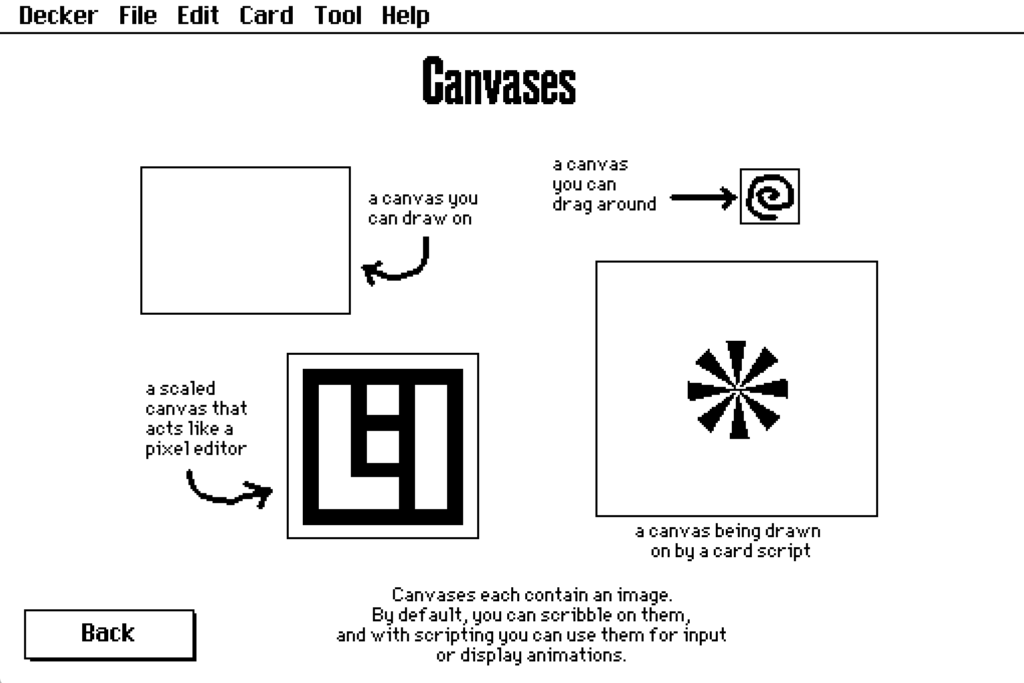
Yet Hypercard still has its fans even today. Decker (not Docker), the subject of this post, is a kind of homage to Hypercard made for current OSes. It looks, on purpose, like it’s a program for early versions of Classic Mac OS, with 1-bit graphics and copious use of dithering. Yet despite that it’s still reasonably powerful. So, rediscover the promise of computing circa the late 80s, with Decker.
Decker (itch.io, $0, for Windows, Mac and Linux)
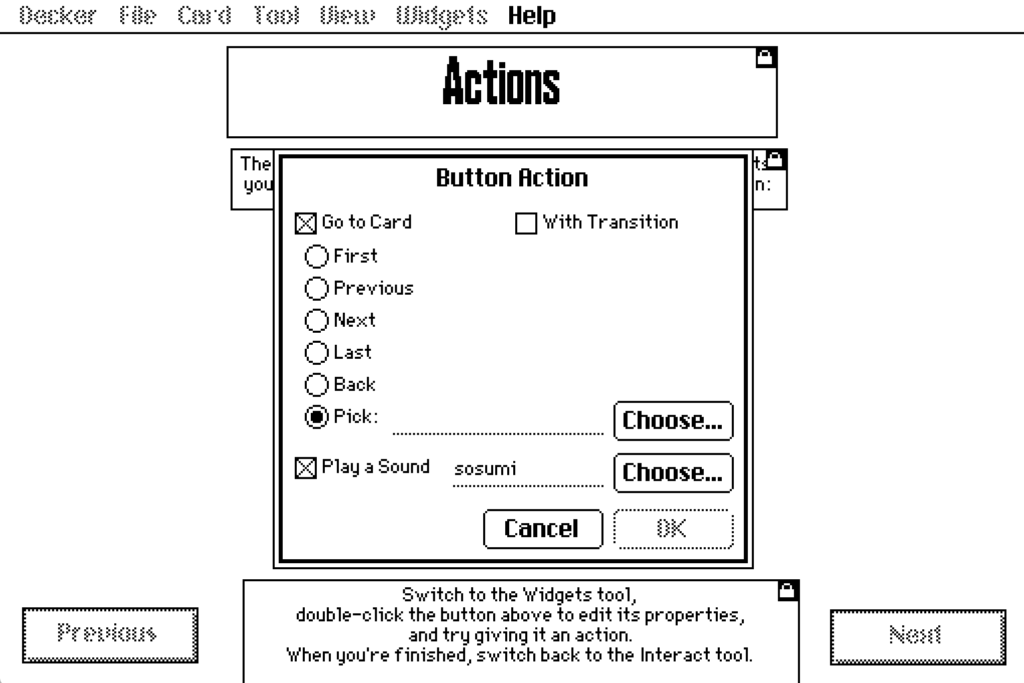
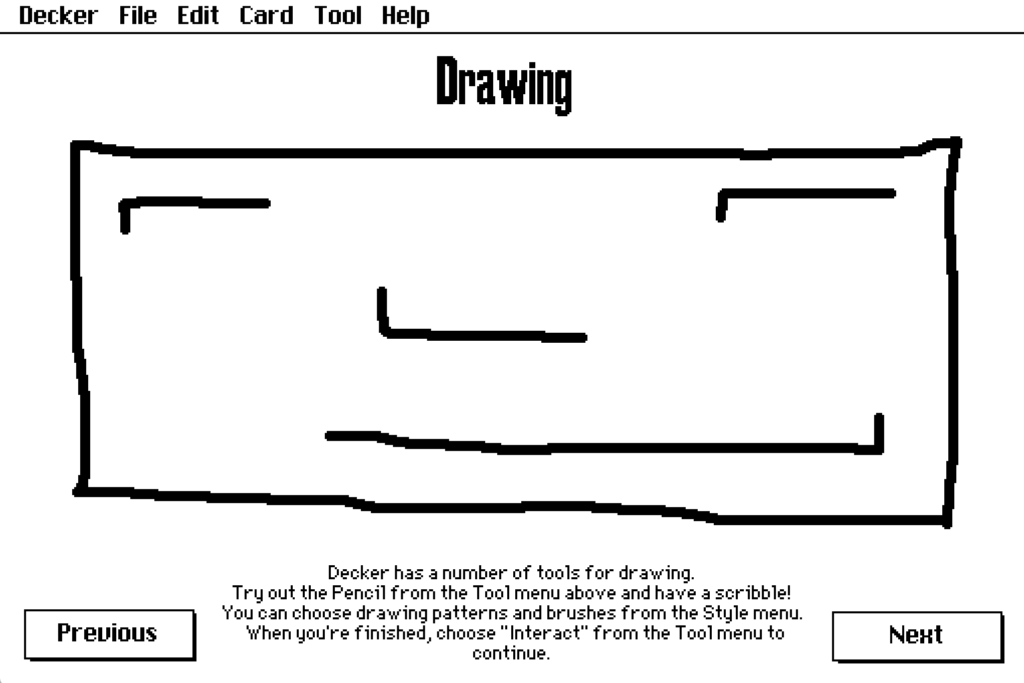
Bolo is a multiplayer tank game, originally for the BBC Micro but remade for classic Macintosh computers. It was a very popular online kind of game for awhile.
It had a popular resource page on the internet, called the Bolo Home Page, made by Joseph Lo and and Chris Hwang, that began as a student project and migrated to the site lgm.com. But then that site went down, and its domain was bought by squatters. So it goes.

Well, vga256 on Mastodon has remade the Bolo Home Page out of the records kept by the Internet Archive. A site composed of hundreds of static HTML pages has risen from the ashes, all (well most) links fixed up to point internally, its content restored as much as is possible. The Internet Archive, for all its greatness, frequently misses images and even whole pages, so there are holes in its record.
Still, most of its content remains. For people who wish to learn about this classic piece of electronic entertainment, a collection of hundreds of pages awaits you!
I’ve never played Bolo myself, I don’t know much about it, but some people it seems were very enthusiastic about it. I don’t think gameplay goes obsolete, it just falls into and out of fashion. Maybe this is a sign. Maybe it’s time for the Second Age of Bolo to begin.
The blog Get Info reveals some facts about Sony’s original game-playing videobox that are not well known! By weight, a lot of this blog is Nintendo stuff, so it’s nice to get some stuff up here about its competitor. They’re all revelations from the book Digital Dreams: The Work of the Sony Design Center by Phil Kunkel. I have no information if he’s related to The Game Doctor from Electronic Games magazine, Bill Kunkel, who passed away in 2011.

The two most interesting facts: it was designed based on the Macintosh Plus, and its plastic case contains a bit of violet to counteract plastic discoloring over time. Oh, why couldn’t Nintendo have foreseen this with the case of the Super Nintendo, it really looks bad when its plastic changes color!
Five interesting facts about the design of the original PlayStation (Get Info)
A while back we linked to Infinite Mac’s surprisingly deep emulation of Mac OS Classic System 7 and Mac OS 8 (they’re both of the same line of operation systems despite the change in name) in web browsers. Since then they’ve also added System 6 and Mac OS 9 to their offerings, in addition to a Japanese version of System 7.
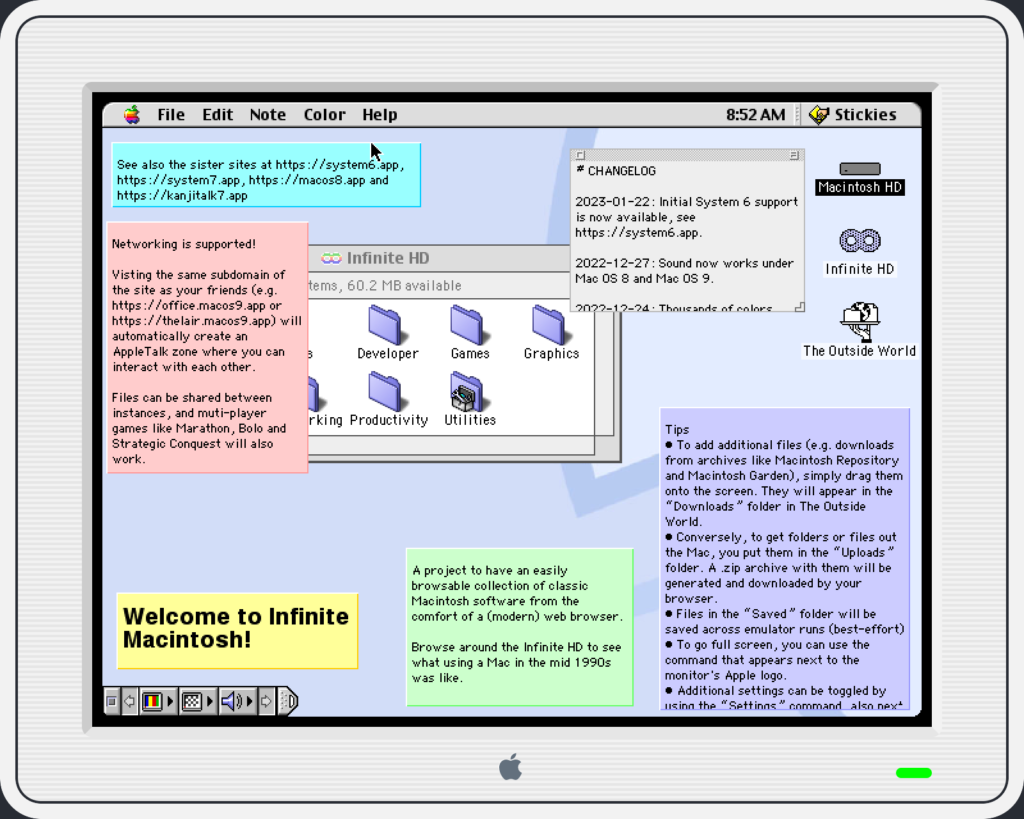
Features a good variety of software including games and productivity, a full-screen mode, built-in networking with friends on the internet by specifying the same subdomain allowing such tricks as online sessions of Marathon, and a fairly easy way of adding your own software.
If you use this and want to keep files between sessions, make sure that you move or copy them to the Saved folder, under The Outside World. Read the purple Sticky for more information on getting files into and out of the emulation.
I find that Classic Mac OS has a power to inspire nostalgia that OS X doesn’t. It might have to do with how so many of its conventions dated back to the original Macintosh release from 1984. Multitasking came to Macintosh after the fact, so when it arrived Mac OS used a cooperative multitasking paradigm, that meant one misbehaving program could bring down the whole machine. Yet the system felt smaller, like there wasn’t as much unfathomable technology between the computer and the user. And I still dig that crisp pixel art used for the icons. It is possible to have too much anti-aliasing.
Infinite Mac’s emulatons of System 6, System 7, Mac OS 8, Mac OS 9 and Japanese System 7.
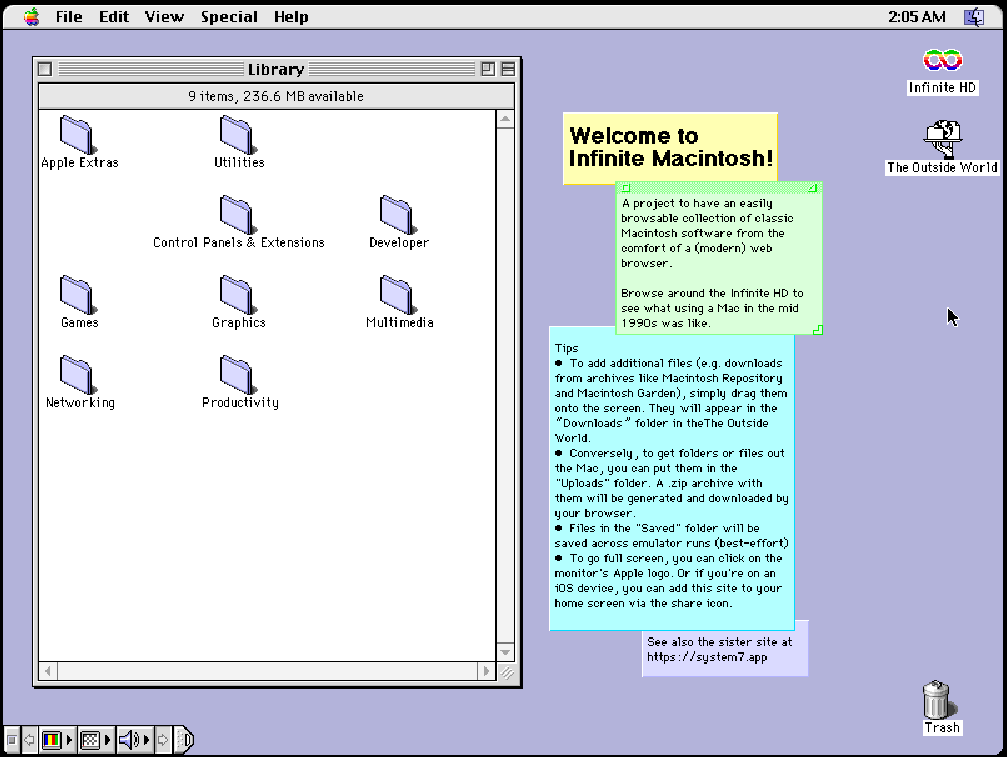
Mihai Parparita (@mihai on Twitter) presents a couple of Classic Mac emulators in-browser, with a good number of programs and games available by default: https://system7.app/ and https://macos8.app/.
The Internet Archive offers in-browser versions of MAME these days for running lots of games. Mihai’s blog post on the sites mentions many of the giants on whose shoulders he stands, including an in-browser version of the Classic Mac emulator Basilisk II. What these sites add is built-in software, including games and productivity software, to use on your virtual Macs, and ways to get files into and out of the emulation easily.